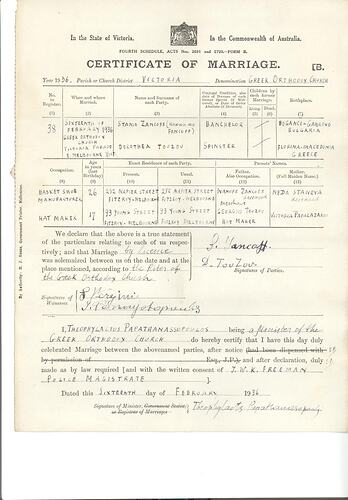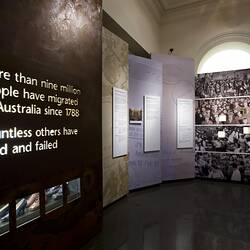Summary
This Certificate of Marriage is a legal document recording the 1936 marriage between Stanio Fancoff and Dorothea Touzou. This document states their occupations as basket shoe manufacturer (Stanio) and hat maker (Dorothea), and reiterates that they were married in the Greek Orthodox Church on 16th of Feburary,1936.
Stanio Ivanoff Fancoff was born in 1908 in Bojentsi, a small village in Bulgaria. At age 11, Stanio left home to learn the shoemaking trade. In 1929, he immigrated to Melbourne, settled in Fitzroy and began to work for the V.G. Zemancheff & Sons basket shoe factory in South Melbourne. In 1936, he married Dorotea Georgi Touzou who had recently arrived in Australia. Around this time, Stanio set up his own shoemaking business from home, with Georgi, her cousin and sister weaving the shoes which he then assembled. Select shoe samples were then taken to Sydney and Tasmania for sale. In 1942, Georgi and Stanio moved to Broken Hill for Georgi's health; there daughter Nancy was born and Stanio set up a shoe shop/factory. In 1945, Georgi died and by 1950 Stanio and Nancy had moved to Adelaide where he again opened a shoemaking business and shop. He passed away in 1978, having been in the shoemaking business for 59 years. This collection documents his migration and working life experiences.
Description of Content
Marriage Certificate for Stanio Fancoff and Dorothea Georgi Touzou on 16/2/1935 at the Greek Orthodox church in Victoria Parade, East Melbourne.
Physical Description
Printed on thin off-white paper, this Certificate of Marriage provides all the details regarding Stanio Fancoff and Dorothea Touzou's union. While the formal writings and their boxes are printed in black ink, the infill spaces and signatures have been hand-written in black ink. The paper is generally an off-white color, but the left hand edges appear in a slightly yellow hue. Furthermore, the paper's left hand edge appears to have been either dashed or perforated, with the top corner missing. The page has one central vertical crease but has four horizontal crease lines.
Significance
This collection is significant in documenting a small migrant business as well as the fashion of a particular period. It is well provenanced and charts the application of trade skills in a new country. It also illustrates the stages of hand shoe manufacture from the 1930s, demonstrating the enduring nature of the tools and patterns that were used.
More Information
-
Collecting Areas
-
Acquisition Information
Donation from Nancy Vasileff, 21 Mar 2007
-
Presented To
Mr Stanio Fancoff, Melbourne, Greater Melbourne, Victoria, Australia, 1936
-
Inscriptions
Text: Front, ink printed: In the State of Victoria. In the Commonwealth of Australia./FOURTH SCHEDULE, ACTS Nos. 2691 and 2720.-FORM B./CERTIFICATE OF MARRIAGE./Year 1936. Parish or Church District VICTORIA Denomination GREEK ORTHODOX CHURCH..., (see extensive text) Text: Back, pencil hand-written: M.L.
-
Classification
-
Category
-
Discipline
-
Type of item
-
Overall Dimensions
209 mm (Width), 271 mm (Height)
-
References
R.A. Salaman, 'Dictionary of Leather-working Tools c.1700-1950 and Tools of Allied Trades,' London: George Allen and Unwin (Publishers) Ltd, 1986 [Section 2: Boot and Shoe Maker pp18-185]. John Peacock. 'Shoes, The Complete Sourcebook,' London:Thames & Hudson Ltd, 2005. NAA holds file (online) on Vasil George Zemancheff, Fancoff's employer
-
Keywords
Boot & Shoemaking, Bulgarian Communities, Bulgarian Immigration, Immigration, Marriage Customs & Rites, Small Businesses, Weddings


